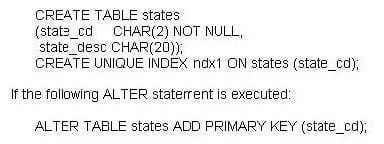A2090-610 Online Practice Questions and Answers
Questions 4
Given the following DDL statement: CREATE TABLE sales (item CHAR(20)); If a DBA wishes to increase the size of the ITEM column, which SQL statement needs to be used?
A. ALTER TABLE sales ADD COLUMN item CHAR(40);
B. ALTER TABLE sales ALTER COLUMN item CHAR(40);
C. ALTER TABLE sales MODIFY COLUMN item CHAR(40);
D. ALTER TABLE sales ALTER COLUMN item SET DATA TYPE CHAR(40);
Questions 5
Which type of lock allows the lock owner and all concurrent applications to read, but not update, the locked data?
A. Share (S)
B. Update (U)
C. Exclusive (X)
D. Intent Exclusive (IX)
Questions 6
If a user has been granted SYSCTRL authority, which activities can they perform?
A. Load operations
B. Backup/copy table spaces
C. Create and drop databases
D. Monitor database performance
Questions 7
A column mask that is to be used for row and column access control (RCAC) was created with the DISABLE option specified. What must be done if this mask is to be used to restrict access to data stored in a table named EMPLOYEE?
A. The column mask must be enabled; the EMPLOYEE table must be altered to activate column access control.
B. The column mask must be enabled (column access control for the EMPLOYEE table will be activated automatically).
C. The EMPLOYEE table must be altered to activate column access control (the column mask will be enabled automatically).
D. The EMPLOYEE table must be altered to activate column access control; row permission must be granted to everyone who needs to use thecolumn mask.
Questions 8
Which SQL statement will allow user USER1 to create a view on a table named EMPLOYEE?
A. GRANT CREATETAB ON DATABASE TO user1
B. GRANT SELECT ON TABLE employee TO user1
C. GRANT CREATEVIEW ON DATABASE TO user1
D. GRANT REFERENCES ON TABLE employee TO user1
Questions 9
Which privilege is required to invoke a user defined function?
A. CALL
B. USAGE
C. EXECUTE
D. REFERENCES
Questions 10
A table named STATES was created as follows:

What will happen?
A. An error will be returned and the operation will fail.
B. A warning will be returned and the unique index INDX1 will become the index for the primary key.
C. The primary key will be successfully added and the unique index INDX1 will be dropped and recreated as the primary key index.
D. The primary key will be successfully added, the unique index INDX1 will be dropped, and a new index will be created for the primary key.
Questions 11
Which case will require a sequence to be dropped and recreated instead of being modified by the ALTER SEQUENCE statement?
A. Change the data type of the sequence.
B. Reset the sequence to its starting value.
C. Establish new minimum or maximum values.
D. Change the increment between future values.
Questions 12
Which type of table should you use if you want to define specific time periods when data is valid?
A. Materialized query table
B. System-period temporal table
C. Declared global temporary table
D. Application-period temporal table
Questions 13
User USER1 wants to store part numbers and part descriptions in a table named PARTS; user USER1 also wants to ensure that any comparisons of part descriptions that are made will be done so in binary, regardless of the database collating sequence used. Which statement should user USER1 execute to create the desired table?
A. CREATE TABLE parts(part_no INTEGER,desc CLOB))
B. CREATE TABLE parts(part_no INTEGER,desc VARCHAR(200))
C. CREATE TABLE parts(part_no INTEGER,desc CLOB FOR BIT DATA))
D. CREATE TABLE parts(part_no INTEGER,desc VARCHAR(200) FOR BIT DATA)
